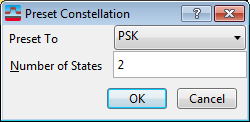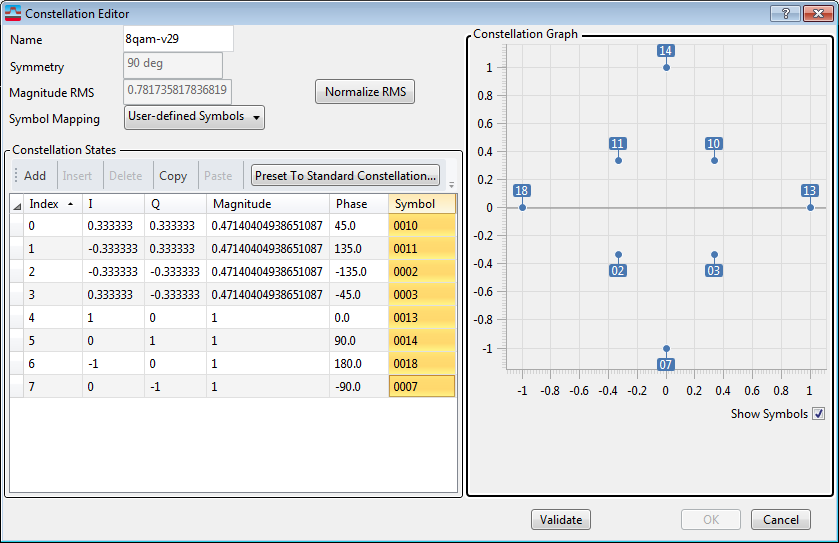Constellation Editor (Custom IQ)
provides a set of controls for creating and customizing IQ constellations:
Name
Enter a unique Name for the custom constellation. If modifying a constellation from an existing Quick Setup, delete the existing name and enter a new name.
The name should consist of alpha, numeric, or dash (-) characters only.
Symmetry
The field displays the angle in degrees by which constellation can be rotated to achieve an equivalent constellation. Value is recomputed when Validate executes.
Magnitude RMS
The field displays the RMS (unitless) computed from the magnitude of the constellation states. This value is recomputed when Validate executes, and it assumes equally probable constellation states.
scales the magnitude of the constellation states to have a unitless RMS of 1. This assumes all constellation states have equal probability.
Symbol Mapping
selects the source from which to derive the symbol mapping for each constellation state within the editor's current constellation. The symbol mapping for the constellation affects what bits are mapped to the demodulated state locations.
When is selected, the symbol value for each constellation state always uses the constellation state's Index value.
When is selected, the symbol value for each constellation state always uses the constellation state's Symbol value. Symbol Mapping changes to User-defined Symbols when an APSK format is selected from the Preset To Standard Constellation menu.
Constellation States
The Constellation States table is an editable list of the points in the constellation. To a new constellation table, start by clicking to open the preset constellation dialog and select the desired type of constellation and number of points.

Each constellation point has the following parameters:
Index – an integer that is for editing purposes only.
I/Q Magnitude/Phase – specifies the location on the complex IQ plane for the constellation point. The range should be -1 to +1 normally, but can be larger if the RMS is set to 1.
Symbol – number that is assigned to this constellation point for modulation/demodulation purposes (in Hexidecimal)

- Adds a new constellation state at the end of the list.
- Inserts a new constellation state above the selected position.
- Deletes the selected constellation state or group of highlighted states.
- Copies the selected constellation state or group of highlighted states into the clipboard for pasting into the Constellation States table or into an Excel spreadsheet.
- Pastes the contents of a copied constellation state or group of constellation states at the selected insertion point in the table. the pasted state information will overwrite the existing constellation state information. If the pasted information exceeds the length of the table, additional rows will be added as necessary.
it is possible to copy a set of constellation locations into and out of an Excel spreadsheet. See Working with Constellation States Table Cells for more information.
- Displays a menu of standard, predefined constellations. Select a standard constellation as a convenient starting point for a custom constellation. For DVB S2 APSK and DVB S2X APSK constellations, the name that appears in the Name field follows the naming used in the DVB standard.

- The zero-based index of this state within the constellation. The state index is used to uniquely identify a constellation state independent of the symbol data.
- The location of the constellation state along the real axis (I-axis) of the complex plane. Default value is 0.0. The state location within a constellation may be specified in terms of I/Q (Real/Imaginary) or Magnitude/Phase.
- The location of the constellation state along the Imaginary axis (Q-axis) of the complex plane. Default value is 0.0. The state location within a constellation may be specified in terms of I/Q (Real/Imaginary) or Magnitude/Phase.
- The magnitude of the constellation state location within the complex plane. Default value is 0.0. The state location within a constellation may be specified in terms of I/Q (Real/Imaginary) or Magnitude/Phase.
- The phase of the constellation state location within the complex plane. Default value is 0.0. The state location within a constellation may be specified in terms of I/Q (Real/Imaginary) or Magnitude/Phase.
If the magnitude is 0, you can not enter a phase value that is non-zero.
- The integer representation of the data symbol represented by the constellation state location. Most significant bit ordering is assumed.
The default symbol value matches the value of Index. This field becomes editable (user-definable) when Symbol Mapping is set to User-defined Symbols. When an APSK format is selected from the Preset To Standard Constellation menu, symbol values will be different from index values.
Constellation Graph
The visually represents the constellation that is configured in the Constellation States list. The graph will update as you build and edit the constellation.
The Constellation Graph reflects the value of the Symbol column. The Symbol column represents the user-defined symbol and becomes editable when is set to .
The Constellation Graph shows the values in the States column even when is the selected symbol mapping.
In the Constellation Graph, the horizontal axis is the “Real” or “I” axis, and the vertical axis is the “Imagninary” or “Q” axis.

Select the checkbox to display the symbol value for each state in the constellation graph.
Validate
Clicking checks the current constellation definition for validity and enables the button. Click to load the custom constellation into the current Custom IQ setup, or click to discard the edits and return to the Custom IQ Demod Properties Format tab.
See Also
